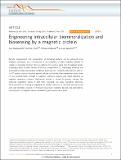Engineering intracellular biomineralization and biosensing by a magnetic protein
Author(s)
Matsumoto, Yuri; Chen, Ritchie; Anikeeva, Polina Olegovna; Jasanoff, Alan Pradip
Downloadncomms9721.pdf (2.282Mb)
PUBLISHER_CC
Publisher with Creative Commons License
Creative Commons Attribution
Terms of use
Metadata
Show full item recordAbstract
Remote measurement and manipulation of biological systems can be achieved using magnetic techniques, but a missing link is the availability of highly magnetic handles on cellular or molecular function. Here we address this need by using high-throughput genetic screening in yeast to select variants of the iron storage ferritin (Ft) that display enhanced iron accumulation under physiological conditions. Expression of Ft mutants selected from a library of 10[superscript 7] variants induces threefold greater cellular iron loading than mammalian heavy chain Ft, over fivefold higher contrast in magnetic resonance imaging, and robust retention on magnetic separation columns. Mechanistic studies of mutant Ft proteins indicate that improved magnetism arises in part from increased iron oxide nucleation efficiency. Molecular-level iron loading in engineered Ft enables detection of individual particles inside cells and facilitates creation of Ft-based intracellular magnetic devices. We demonstrate construction of a magnetic sensor actuated by gene expression in yeast.
Date issued
2015-11Department
Massachusetts Institute of Technology. Department of Biological Engineering; Massachusetts Institute of Technology. Department of Brain and Cognitive Sciences; Massachusetts Institute of Technology. Department of Materials Science and Engineering; Massachusetts Institute of Technology. Department of Nuclear Science and Engineering; Massachusetts Institute of Technology. Research Laboratory of ElectronicsJournal
Nature Communications
Publisher
Nature Publishing Group
Citation
Matsumoto, Yuri, Ritchie Chen, Polina Anikeeva, and Alan Jasanoff. “Engineering Intracellular Biomineralization and Biosensing by a Magnetic Protein.” Nat Comms 6 (November 2, 2015): 8721. © 2015 Macmillan Publishers Limited
Version: Final published version
ISSN
2041-1723